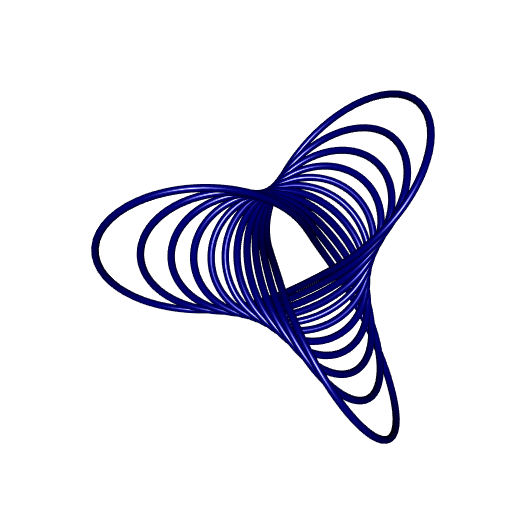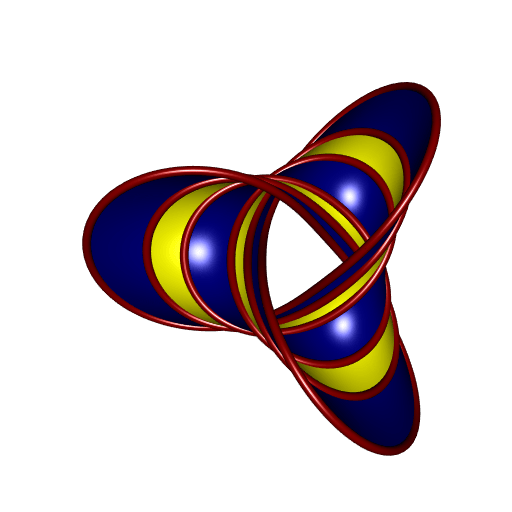Four-dimensional torus knots
Here is a parameterization of a four-dimensional torus knot: \[ p(\theta, \phi) = \begin{pmatrix} \cos\theta \cdot \cos\phi \\ \cos\theta \cdot \sin\phi \\ \sin\theta \cdot \cos 3\phi/2 \\ \sin\theta \cdot \cos 3\phi/2 \end{pmatrix} \] It takes its values in the 3-sphere. We use the stereographic projection to project from the 3-sphere to the three-dimensional space, and then we will try to visualize the stereographic projection of this knot.
trefoil4D <- function(theta, phi) {
cbind(
cos(theta) * cos(phi),
cos(theta) * sin(phi),
sin(theta) * cos(1.5*phi),
sin(theta) * sin(1.5*phi)
)
}
trefoil3D <- function(theta, phi) {
q <- trefoil4D(theta, phi)
q[, c(1L,2L,3L)] / (1 - q[, 4L])
}One possible way to visualize it consists in plotting some tubes around the curves \(\phi \mapsto \textrm{Stereo}\bigl(p(\theta, \phi)\bigr)\) for a series of values of \(\theta\).
library(rgl)
# take 6 values of theta
theta_ <- seq(0, by = 0.175, length.out = 6L)
# phi ranges from 0 to 4*pi
phi_ <- seq(0, 4*pi, length.out = 400L)
# plot
open3d(windowRect = 50 + c(0, 0, 512, 512), zoom = 0.95)
for(theta in theta_) {
pts <- trefoil3D(theta, phi_)
tube <- addNormals(
cylinder3d(pts, radius = 0.05, sides = 30),
)
shade3d(tube, color = "navy")
}
Another way to visualize it consists in plotting again such tubes and to plot the surfaces between them, using alternating colors. But wait, I will comment that after displaying this plot. I use the parametricMesh function of the cgalMeshes package to create the meshes of the surfaces (this package has been archived on CRAN but hopefully it will be back soon).
library(cgalMeshes)
# tubes
phi_ <- seq(0, 4*pi, length.out = 400L)
pts <- trefoil3D(pi/12, phi_)
tube1 <- addNormals(
cylinder3d(pts, radius = 0.05, sides = 30),
)
pts <- trefoil3D(pi/6, phi_)
tube2 <- addNormals(
cylinder3d(pts, radius = 0.05, sides = 30),
)
pts <- trefoil3D(pi/4, phi_)
tube3 <- addNormals(
cylinder3d(pts, radius = 0.05, sides = 30),
)
# surfaces; we need to transpose in order to use `parametricMesh`
trefoil <- function(theta, phi) {
t(trefoil3D(theta, phi))
}
mesh1 <- addNormals(parametricMesh(
trefoil, c(0, pi/12), c(0, 4*pi), periodic = c(FALSE, TRUE),
nu = 50L, nv = 600L
))
mesh2 <- addNormals(parametricMesh(
trefoil, c(pi/12, pi/6), c(0, 4*pi), periodic = c(FALSE, TRUE),
nu = 50L, nv = 600L
))
mesh3 <- addNormals(parametricMesh(
trefoil, c(pi/6, pi/4), c(0, 4*pi), periodic = c(FALSE, TRUE),
nu = 50L, nv = 600L
))
# plot
open3d(windowRect = 50 + c(0, 0, 512, 512), zoom = 0.9)
shade3d(mesh1, color = "navy")
shade3d(mesh2, color = "yellow")
shade3d(mesh3, color = "navy")
shade3d(tube1, color = "darkred")
shade3d(tube2, color = "darkred")
shade3d(tube3, color = "darkred")
Now here is my promised comment. Do you notice something strange? I said we will fill the surfaces between the tubes. However there are three tubes and there are three surfaces.
Go to this gist if you want to play with other four-dimensional torus knots.







